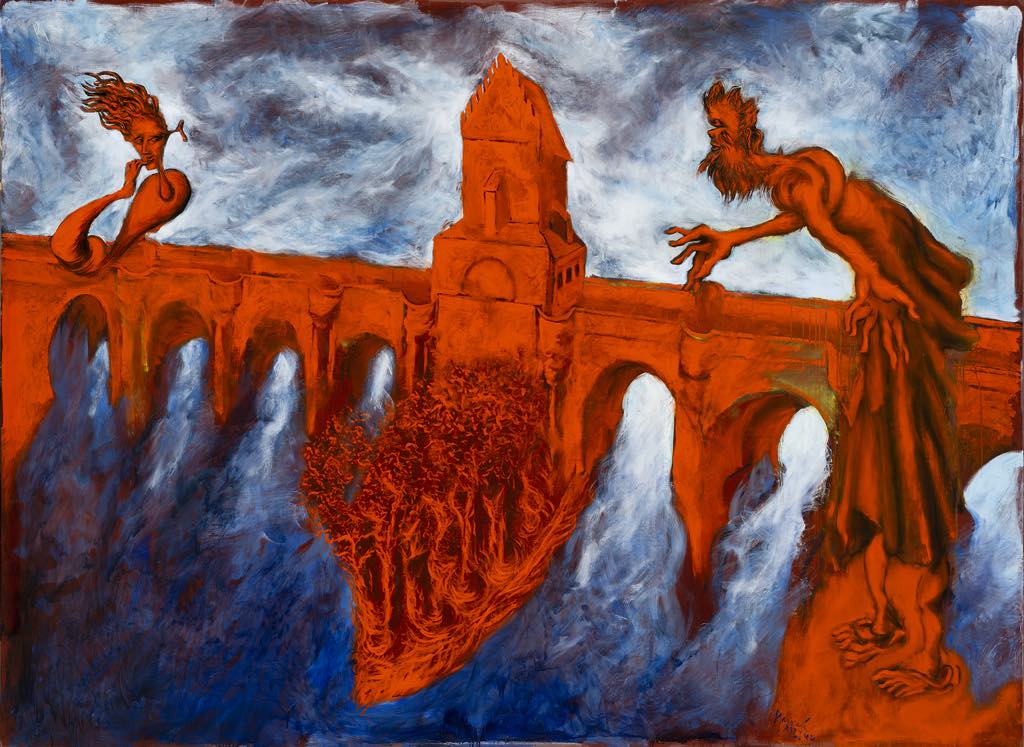
The prolific French painter Gérard Garouste (b. 1946) likes a good story, whether it comes from mythology, religion or fiction. He seems to use these sources to explore the depths of his own unconscious – expressed through colorful, energetically painted large-format figurative works – and perhaps to prod viewers to do the same.
In recent exhibitions, Garouste has explored stories from such sources as the Talmud and Greek mythology, and in the current show, “Correspondences,” at Paris’s Galerie Templon Grenier Saint Lazare, he takes inspiration from discussions with a friend, the philosopher Marc-Alain Ouaknin, who approaches philosophy through stories from the Bible, the Talmud, the Kabbalah and the work of Franz Kafka.
“From their weekly meetings,” according to the exhibition catalog, “came reflections on the ‘Alt-Neu’ (the old-new), a way of recalling how, thanks to language and images, both thought and artistic practice draw on a permanent to-and-fro between ancient and modern.”

Garouste, inspired by Ouaknin, takes delight in the correspondences in these works. A great example is the monumental triptych “Le Banquet,” which revels in imagery illustrating some of the concordances between Franz Kafka (who is associated with martens and squirrels in many of the paintings), and the Kaballah. “Everything is linked,” says the artist. “Each story sends us to another story, and by recounting them all, we recount the whole world.”

Kafka, the main character in the central painting in the triptych, stands on the right with a bird on his head, ignoring the strange feathered human figure leaning on him with an expression of great anguish on his face. A dozen figures are seated at the banquet table next to them, some of them recognizable as those who knew Kafka or wrote about him, among them Martin Buber, Walter Benjamin, the philosopher Gershom Scholem and the psychoanalyst Éliane Amado Levy-Valensi, a great admirer of the work of Kafka. She holds in her hand a book of the correspondence between Scholem and his mother, Betty, in which Scholem speaks of a zeppelin flying over Israel during Purim and scattering confetti over the celebrants.
Garouste transposes this carnival to Venice, and in the painting on the left, we see a zeppelin dropping confetti on costumed figures hovering over the Grand Canal.
In the painting on the right, the falling confetti is associated with the manna falling from heaven in the Bible story: Garouste has painted a version of Tintoretto’s “The Manna Harvest,” with an upside-down figure throwing – or catching? – the confetti/manna.
Taking the connection full circle, Garouste noted in an interview that, in the Bible, manna is described as “like coriander seed,” and it turns out that the Italian word for “confetti” is “coriandoli.”
As Garouste says in the film accompanying the exhibition, “Alt-Neu-Kunst” (Old-New Art), “What I would like people to see in the paintings is not what is visible, but what is invisible, what is in between, the slips of the tongue.”
Although many of the figures in these paintings may be familiar to us, the meaning of the works remains obscure to the casual observer, even while they jar something in us – in an often disturbing fashion – with their strong, sometimes strident colors, figural distortions and weird juxtapositions. It’s up to the viewer to decide whether or not to try to decipher the complex puzzle of “correspondences” found in the paintings as Garouste tries to find meaning in a meaningless – Kafkaesque – world. It’s a fascinating game.
Note: The Galerie Templon is currently closed due to Covid restrictions but has created a virtual viewing room for the exhibition.
Favorite